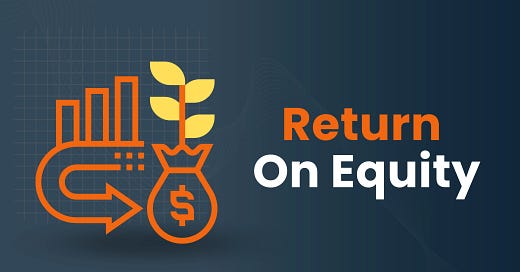What is Return on Equity?
Let's understand the most popular and essential metric for equity investors
You wouldn't want a car with a lousy mileage. So why should your stock investments be any different?
Return on equity (RoE) is essentially the mileage of a business. It is a percentage figure that helps you gauge how efficiently a company is capable of using your investments to generate profits - the higher the return on equity, the more efficient the company's management.
How is it calculated
You need to know two figures to calculate RoE - net income and shareholder's equity.
Net Income
Net income is the total amount of money a business has earned in a given period after subtracting expenses, such as expenses it has incurred to run the business, interest payments on the loans it might have taken, taxes, amortisation, and depreciation. This figure is present at the end of a company's profit and loss statement.
Shareholders' equity
Shareholders' equity represents the amount of money that will be returned to the shareholders if a company is liquidated, i.e., all its assets are sold, and debts are repaid. In simpler terms, it reflects the amount of money investors have invested. It can be calculated from the profit and loss statement by subtracting the company's liabilities from its assets.
Shareholders' equity = Assets - Liabilities
Once you know the net income and shareholders' equity, the return on equity formula is simple:
Return on equity (%) = (Net income/Shareholders' equity) X 100
How to use it
Lets assume you are confused about which stock to buy: Company A or Company B. Both companies have recorded a net profit or net income of $20 Million in a year, so the profit doesn't provide a clear choice.
The answer to this dilemma is simple. You open up their annual report, go to the profit and loss statement and calculate the RoE for each company.
Let's say:
Shareholder equity of Company A = $100 Million
Shareholder equity of Company B = $200 Million
Therefore,
RoE of company A (%) = ($20M/ $100M) X 100 = 20%
RoE of company B (%) = ($20M/ $200M) X 100 = 10%
Now the choice looks quite clear. Company A with a higher RoE is more likely to manage your invested money efficiently and give you better returns.
Drawbacks
While RoE is one of the most useful metrics for investors, it is not without its drawbacks.
Sensitive to buybacks
The first drawback is evident from the return on equity formula itself. If the number of shares of a company decreases, shareholders' equity decreases. And as shareholders' equity is in the denominator, the RoE increases. Thus, if a company executes a buyback, where it repurchases shares from its shareholders, its RoE will rise and give a false impression that the management has suddenly become more efficient.
It doesn't take debt into account
If a company increases its earnings using debt, it can easily inflate the RoE. However, growth on the back of high debt is not a good indicator for any company.
Prone to manipulation through accounting jugglery
Revenues and income reflected in a profit and loss statement can be manipulated using various accounting techniques, impacting the RoE. For instance, if a company chooses to show a longer life for assets, depreciation expense will decrease. This will increase the net income and, thereby, the RoE. However, this higher RoE won't be due to better efficiency on the management's part.
Summary
RoE is a great tool to assess the management efficiency and acumen, but as with any other financial ratio it must be used in conjunction with other financial metrics like debt levels, RoIC, cash flows, etc.
Thank you for reading this article! If you liked it please hit the LIKE button.
I hope you got some value out of this article. Please feel free to share this newsletter with your friends or family.
Disclaimer: Please do not consider this post as an investment advice. I am not a registered financial advisor. Nothing in this article should be construed as an investment advice. Please consult a registered financial advisor before making any investment decisions.
Credits: Most of the content of this article is public information that can be found on news articles, government and company websites.




